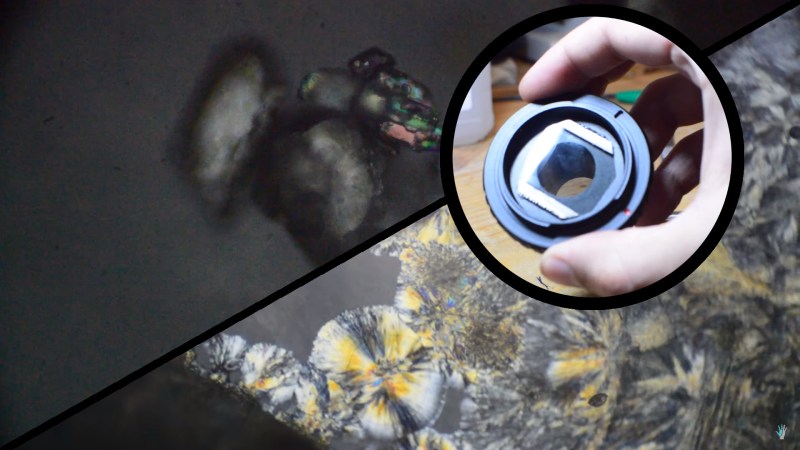Most of us have heard some form of the adage, “You can buy cheaper, but you’ll never pay less.” It means that cheaper products ultimately do not stand up to the needs of their superior counterparts. Hackers love to prove this aphorism wrong by applying inexpensive upgrades to inexpensive tools to fill up a feature-rich tool bag. Take [The Thought Emporium] who has upgraded an entry-level microscope into one capable of polarized and dark-field microscopy. You can also see the video after the break.
Functionally, polarized images can reveal hidden features of things like striations in crystals or stress lines in hot glue threads. Dark-field microscopy is like replacing the normally glaring white background with a black background, and we here at Hackaday approve of that décor choice. Polarizing filters sheets are not expensive and installation can be quick, depending on your scope. Adding a dark-field filter could cost as much as a dime.
Like most mods, the greatest investment will be your time. That investment will pay back immediately by familiarizing you with your tools and their workings. In the long-run, you will have a tool with greater power.
Simple mods like the light source can be valuable, but upgrades are not limited to optical scopes, an electron microscope was brought back to life with Arduino
















How about lightfield microscopy with lightfield (Lytro) camera:
https://arxiv.org/abs/1508.03590
You might also like seeing things in 3d on the same microscope. See http://www.funsci.com/fun3_en/hmster/hmster_en.htm
Oooh, I did that not one month ago, what a coincidence! The polarizing film was stripped from a broken LCD panel, of course. By the way, this is a great tool for liquid crystal research; I tried to put a liquid crystal sample under a polarizing microscope, and the results were pretty amazing: I could see a nematic schlieren texture and observe a phase transition on heating with a hair dryer. LCs are normally quite expensive if purchased commercially (something like $250 for one gram of 4-cyano-4′-pentylbiphenyl — far more than I was willing to pay!), but mine came free courtesy of the same broken LCD panel=)
Awesome… reminds me of this instructable ( http://www.instructables.com/id/Convert-a-1980s-Video-Camera-Into-a-Real-Time-Pola/ ) though way way more cost effective and a different application that is really effective. I’m surprised how cost effective some of the filters are like with some of the diffraction gratings and I’m guessing a printed mount for the filter over the light with a dial indicator will help with determining repeatable method for viewing if making a procedure.
If I recall properly, my Tasco microscope I got about 1969 had a polarizer. It was a low end kid’s microscope, comolete with accessories and even brine shrimp eggs.
Michael